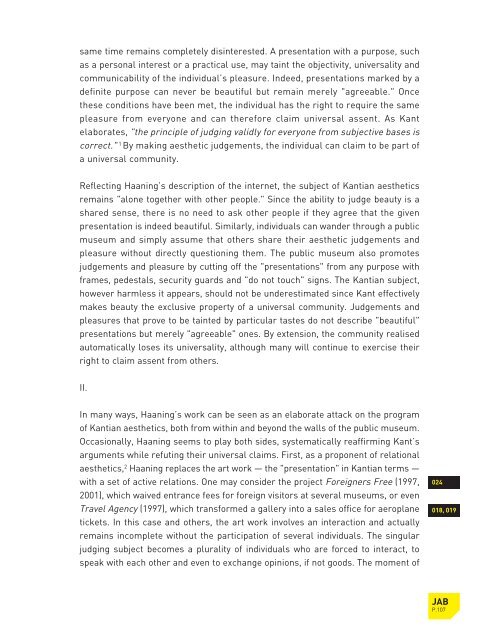download catalogue high resolution pdf (22.3 mb) - Jens Haaning
download catalogue high resolution pdf (22.3 mb) - Jens Haaning
download catalogue high resolution pdf (22.3 mb) - Jens Haaning
You also want an ePaper? Increase the reach of your titles
YUMPU automatically turns print PDFs into web optimized ePapers that Google loves.
same time remains completely disinterested. A presentation with a purpose, such<br />
as a personal interest or a practical use, may taint the objectivity, universality and<br />
communicability of the individual’s pleasure. Indeed, presentations marked by a<br />
definite purpose can never be beautiful but remain merely "agreeable." Once<br />
these conditions have been met, the individual has the right to require the same<br />
pleasure from everyone and can therefore claim universal assent. As Kant<br />
elaborates, "the principle of judging validly for everyone from subjective bases is<br />
correct." 1 By making aesthetic judgements, the individual can claim to be part of<br />
a universal community.<br />
Reflecting <strong>Haaning</strong>’s description of the internet, the subject of Kantian aesthetics<br />
remains "alone together with other people." Since the ability to judge beauty is a<br />
shared sense, there is no need to ask other people if they agree that the given<br />
presentation is indeed beautiful. Similarly, individuals can wander through a public<br />
museum and simply assume that others share their aesthetic judgements and<br />
pleasure without directly questioning them. The public museum also promotes<br />
judgements and pleasure by cutting off the "presentations" from any purpose with<br />
frames, pedestals, security guards and "do not touch" signs. The Kantian subject,<br />
however harmless it appears, should not be underestimated since Kant effectively<br />
makes beauty the exclusive property of a universal community. Judgements and<br />
pleasures that prove to be tainted by particular tastes do not describe "beautiful"<br />
presentations but merely "agreeable" ones. By extension, the community realised<br />
automatically loses its universality, although many will continue to exercise their<br />
right to claim assent from others.<br />
II.<br />
In many ways, <strong>Haaning</strong>’s work can be seen as an elaborate attack on the program<br />
of Kantian aesthetics, both from within and beyond the walls of the public museum.<br />
Occasionally, <strong>Haaning</strong> seems to play both sides, systematically reaffirming Kant’s<br />
arguments while refuting their universal claims. First, as a proponent of relational<br />
aesthetics, 2 <strong>Haaning</strong> replaces the art work — the "presentation" in Kantian terms —<br />
with a set of active relations. One may consider the project Foreigners Free (1997,<br />
2001), which waived entrance fees for foreign visitors at several museums, or even<br />
Travel Agency (1997), which transformed a gallery into a sales office for aeroplane<br />
tickets. In this case and others, the art work involves an interaction and actually<br />
remains incomplete without the participation of several individuals. The singular<br />
judging subject becomes a plurality of individuals who are forced to interact, to<br />
speak with each other and even to exchange opinions, if not goods. The moment of<br />
024<br />
018, 019<br />
JAB<br />
P.107


